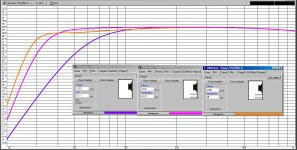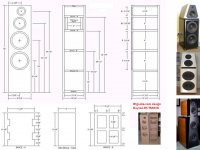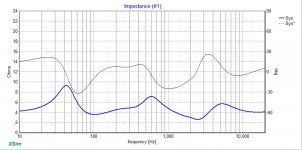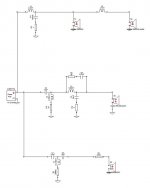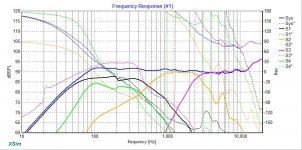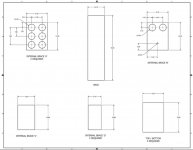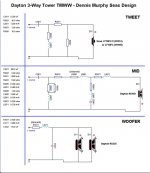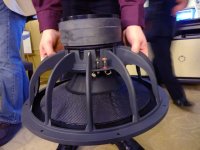Hi To All,
I'm looking at building a dual woofer system in its own separate enclosure from tweeter and mid range. The woofers are Dayton RS225-8 8" in a sealed cabinet. My question is should I prefer to design crossover for a 3 way or 3.5 way with a single inductor for BSC? The room size is 10 feet by 25 feet dimensions, so I'm not positive if full BSC is required. There may be other design considerations that could come from the discussion. I have attached a photo of one of the cabinets under construction (recycled Pioneer CS77 cabs). Still need to attach 18mm Baltic Birch baffle. Thanks in advance for responses!
Best Regards,
Rich
I'm looking at building a dual woofer system in its own separate enclosure from tweeter and mid range. The woofers are Dayton RS225-8 8" in a sealed cabinet. My question is should I prefer to design crossover for a 3 way or 3.5 way with a single inductor for BSC? The room size is 10 feet by 25 feet dimensions, so I'm not positive if full BSC is required. There may be other design considerations that could come from the discussion. I have attached a photo of one of the cabinets under construction (recycled Pioneer CS77 cabs). Still need to attach 18mm Baltic Birch baffle. Thanks in advance for responses!
Best Regards,
Rich
Attachments
BSC has more to do with frequency, boudary reinforcement and baffle size than room size. I think most subwoofers can ignore it altogether.
What frequency are you planning your cut-off for the 8" drivers?
My advice is for all crossover design is always to measure first, and measure in place. Put the drives in for a test run and do some measurements with Room EQ Wizard and OmniMic or what have you and see the kind of in-room output you get.
What frequency are you planning your cut-off for the 8" drivers?
My advice is for all crossover design is always to measure first, and measure in place. Put the drives in for a test run and do some measurements with Room EQ Wizard and OmniMic or what have you and see the kind of in-room output you get.
What mid?
Generally, it's much easier to cross to the mid at the BSC frequency...as long as you're not using a dome midrange.
Generally, it's much easier to cross to the mid at the BSC frequency...as long as you're not using a dome midrange.
Hi Eric,
I'm looking at around 475 to 525 hz crossover point. Everything you mentioned about measurements is what I had planned. This winter its all about cabinet construction. Then move on taking measurements. With more questions to follow.🙂 I'm just trying to learn more on the subject of 3 way vs. 3.5 way.
Face,
I just purchased Dayton RS150P for mid range and Scanspeak R2604-8330 tweeters. They will be housed in separate enclosure very similar to Troels Gravesen's SBA-10 truncated pyramid.
Thanks for Replies,
Rich
I'm looking at around 475 to 525 hz crossover point. Everything you mentioned about measurements is what I had planned. This winter its all about cabinet construction. Then move on taking measurements. With more questions to follow.🙂 I'm just trying to learn more on the subject of 3 way vs. 3.5 way.
Face,
I just purchased Dayton RS150P for mid range and Scanspeak R2604-8330 tweeters. They will be housed in separate enclosure very similar to Troels Gravesen's SBA-10 truncated pyramid.
Thanks for Replies,
Rich
Depends on how your woofers behave in the sealed cabinet, the idea of the .5 way is to add more lows where the next upper driver is falling off in level, so if one woofer is falling off at a certain point, you can cross the .5 one over there to maintain level to a lower point. With 2 woofers the same in a sealed box, this becomes pointless, because they will both behave the same way. Better to make the .5 woofer ported. (Hope that makes sense, I'm half asleep at the mo...)
(Hope that makes sense, I'm half asleep at the mo...)
Come back after some coffee. 😉
Hahaha, Face is now using my "drunken posting" defence. 🙂
I've been thinking about this. I'd keep 1 of your Audax drivers for mid, and consider an 8" to 10" as a real woofer.
I've been thinking about this. I'd keep 1 of your Audax drivers for mid, and consider an 8" to 10" as a real woofer.
PeteMcK,
Thanks for your input. Everything you mentioned makes perfect sense. My only concern is it would be difficult at this stage to separate the cabinet into two sections. One bass driver in sealed compartment and one ported. I certainly can change design goals and go with a ported enclosure. I did a quick model in Unibox and it looks like 39 liter vb tuned to somewhere around 30-32 hz works.
Eric,
Maybe you need a couple cups of coffee too.😀 For one, I do not have any Audax drivers to utilize anywhere. Secondly, the Dayton RS225's are an 8" woofer and I currently have two.🙂 Still will need to purchase another two at a later date.
Thanks for your input. Everything you mentioned makes perfect sense. My only concern is it would be difficult at this stage to separate the cabinet into two sections. One bass driver in sealed compartment and one ported. I certainly can change design goals and go with a ported enclosure. I did a quick model in Unibox and it looks like 39 liter vb tuned to somewhere around 30-32 hz works.
Eric,
Maybe you need a couple cups of coffee too.😀 For one, I do not have any Audax drivers to utilize anywhere. Secondly, the Dayton RS225's are an 8" woofer and I currently have two.🙂 Still will need to purchase another two at a later date.
Sorry. I need more htan coffee, I need a caffeinated blood transfusion. I was clearly typing in the wrong thread about the wrong drivers. Some days when you are sick it just does not pay to try to think.
Last edited:
Hi Eric, Hope you are feeling better. Please know I was only joking about and meant no disrespect. After re-reading my post, I can see how it may have seemed sarcastic. That certainly was not my intent. Best Regards, Rich
Hi,
No hard and fast rules, decide at the modelling stage.
Around 500Hz x/o point seems high to me.
rgds, sreten.
No hard and fast rules, decide at the modelling stage.
Around 500Hz x/o point seems high to me.
rgds, sreten.
montana1
When I ran a simple WinISD sim of two Dayton RS225-8 aluminum cone woofers the data showed that a sealed 1.6cuft cabinet will only reached -F3 ~50Hz, so you would still need subwoofers. A ported box with 2.9cuft generates -F3 ~32Hz, which provides strong stand-alone bass.
A 3cuft ported woofer cabinet volume is often shared with the TM to reduce the total physical size.
Have you studied the Dayton TMWW developed by the Htguide.com team? The Dennis Murphy Design? Most of this research can be used with a slightly differently shaped 2-cabinet TM-WW construction. Troels SB10 uses a completely different Xover philosophy.
http://www.htguide.com/forum/showth...RS-WMTW-amp-TMWW-cabinet-plans&highlight=TMWW
http://www.htguide.com/forum/showth...rom-the-3-way-WTMW-TMWW-thread&highlight=TMWW
When I ran a simple WinISD sim of two Dayton RS225-8 aluminum cone woofers the data showed that a sealed 1.6cuft cabinet will only reached -F3 ~50Hz, so you would still need subwoofers. A ported box with 2.9cuft generates -F3 ~32Hz, which provides strong stand-alone bass.
A 3cuft ported woofer cabinet volume is often shared with the TM to reduce the total physical size.
Have you studied the Dayton TMWW developed by the Htguide.com team? The Dennis Murphy Design? Most of this research can be used with a slightly differently shaped 2-cabinet TM-WW construction. Troels SB10 uses a completely different Xover philosophy.
http://www.htguide.com/forum/showth...RS-WMTW-amp-TMWW-cabinet-plans&highlight=TMWW
http://www.htguide.com/forum/showth...rom-the-3-way-WTMW-TMWW-thread&highlight=TMWW
Attachments
LineSource,
Thanks for the links and screenshots. I will take a close look at other designs that are close to what I have in mind (as the one's you referenced). Just so you know, I mentioned Troels only because the top enclosure I'm building is very similar in shape. As Sreten suggested, the time to decide is at the modelling stage. From modelling these drivers in both Unibox and WinISD, it appears sealed box would be the way to go. Ported seems possible, but only by heavy fill added (limited to 39 liters approx.). I really appreciate the input you have given. One design goal that I failed to mention earlier, was the added sensitivity gains by coupling two woofers in parallel. If I could match mid and tweeter around 89 db or so would be great.
Best Regards,
Rich
Thanks for the links and screenshots. I will take a close look at other designs that are close to what I have in mind (as the one's you referenced). Just so you know, I mentioned Troels only because the top enclosure I'm building is very similar in shape. As Sreten suggested, the time to decide is at the modelling stage. From modelling these drivers in both Unibox and WinISD, it appears sealed box would be the way to go. Ported seems possible, but only by heavy fill added (limited to 39 liters approx.). I really appreciate the input you have given. One design goal that I failed to mention earlier, was the added sensitivity gains by coupling two woofers in parallel. If I could match mid and tweeter around 89 db or so would be great.
Best Regards,
Rich
Hi LineSource,
Here is a few screenshots of some very preliminary work that I started in Xsim. Keep in mind, these were done using Dayton data files run through Bagby's Response Modeller for woofers and mid. Zaph Audio for file on Scanspeak D2604/83300. By next spring, I hope to acquire my own gear to measure drivers but for now I'm just trying to spend a lot of time reading posts on this forum and learning more about this fine hobby.🙂 Also, learning the many programs available to model both box and Xover. Yike! It's steeper terrain then what I see here in North Idaho.😀
Best,
Rich
Here is a few screenshots of some very preliminary work that I started in Xsim. Keep in mind, these were done using Dayton data files run through Bagby's Response Modeller for woofers and mid. Zaph Audio for file on Scanspeak D2604/83300. By next spring, I hope to acquire my own gear to measure drivers but for now I'm just trying to spend a lot of time reading posts on this forum and learning more about this fine hobby.🙂 Also, learning the many programs available to model both box and Xover. Yike! It's steeper terrain then what I see here in North Idaho.😀
Best,
Rich
Attachments
Hey montana1,
I like the separate cabinet design. It has some nice advantages.
How much total Vb do you have for your 2 woofers? I have to agree with LineSource, sealed doesn't offer you much in terms of the bottom end. In a smallish room, you might be able to get away with an F3 of about 40Hz-45Hz or so for music. See how much ported Vb you need for that (try an Fb around 30Hz-35Hz) and see if you can accommodate it.
Re bsc, room size isn't quite as important as speaker placement. If they are more or less out away from walls, they are more likely to need the full 6dB. Closer to walls and you may need less. Room size and room leakage have more effect on the bass tuning. Be aware that if you need less bsc, you may need to go with higher sensitivity on your mid.
Go with a 3-way. You can make a 3.5-way work but there is no reason for it. You are only adding unnecessary complexity. In a 3-way, when your mid can go as low as the baffle step frequency, then just treat the 2 woofers as one. Now if you were perhaps using a smaller mid that required a higher xo frequency, so well above the baffle step frequency, running a 3.5-way makes sense. See how Zaph has used a 3.5-way with his ZDT3.5 but Curt just goes with a 3-way with his Statements.
In your sim, you still need to work on the mid/tweeter phase alignment but you've come a long way from where you started out. Nice work. 🙂
I like the separate cabinet design. It has some nice advantages.
How much total Vb do you have for your 2 woofers? I have to agree with LineSource, sealed doesn't offer you much in terms of the bottom end. In a smallish room, you might be able to get away with an F3 of about 40Hz-45Hz or so for music. See how much ported Vb you need for that (try an Fb around 30Hz-35Hz) and see if you can accommodate it.
Re bsc, room size isn't quite as important as speaker placement. If they are more or less out away from walls, they are more likely to need the full 6dB. Closer to walls and you may need less. Room size and room leakage have more effect on the bass tuning. Be aware that if you need less bsc, you may need to go with higher sensitivity on your mid.
Go with a 3-way. You can make a 3.5-way work but there is no reason for it. You are only adding unnecessary complexity. In a 3-way, when your mid can go as low as the baffle step frequency, then just treat the 2 woofers as one. Now if you were perhaps using a smaller mid that required a higher xo frequency, so well above the baffle step frequency, running a 3.5-way makes sense. See how Zaph has used a 3.5-way with his ZDT3.5 but Curt just goes with a 3-way with his Statements.
In your sim, you still need to work on the mid/tweeter phase alignment but you've come a long way from where you started out. Nice work. 🙂
Hi jReave,
Great to here from you! Hope this year has treated you well.🙂 Any comments you may have, are more then welcome as always!
Once I braced these Pioneer cabs vb was reduced to approximately 39 liters. The best F3 I could achieve in Unibox was 49 hz sealed with a Qtc of .799 and F3 of 46 hz vented with 32 hz Fb *(required heavy fill to avoid peaking response). Throughout the day, I have been considering building a pedestal that matches dimensions of Pioneer cab that can be used for additional volume gains. This would also serve to create more separation from floor to center of lower woofer. It appears that the guys on HtGuide were going with 62 liters sealed or 80+ vented. Either way, I believe purchasing another sheet of 18mm Baltic Birch plywood is in order and doing this build right. My goal is to take my time and not be in a big hurry, so this is excellent feedback that I have received thus far.
Thanks for compliment on progress.🙂 Yea, the Xover I posted does need much more refinement. I was just trying to get a preliminary idea what a 3 way schematic might look like. I will nix the .5 way idea and treat it like Curt's design.
Best Regards,
Rich
Great to here from you! Hope this year has treated you well.🙂 Any comments you may have, are more then welcome as always!
Once I braced these Pioneer cabs vb was reduced to approximately 39 liters. The best F3 I could achieve in Unibox was 49 hz sealed with a Qtc of .799 and F3 of 46 hz vented with 32 hz Fb *(required heavy fill to avoid peaking response). Throughout the day, I have been considering building a pedestal that matches dimensions of Pioneer cab that can be used for additional volume gains. This would also serve to create more separation from floor to center of lower woofer. It appears that the guys on HtGuide were going with 62 liters sealed or 80+ vented. Either way, I believe purchasing another sheet of 18mm Baltic Birch plywood is in order and doing this build right. My goal is to take my time and not be in a big hurry, so this is excellent feedback that I have received thus far.
Thanks for compliment on progress.🙂 Yea, the Xover I posted does need much more refinement. I was just trying to get a preliminary idea what a 3 way schematic might look like. I will nix the .5 way idea and treat it like Curt's design.
Best Regards,
Rich
Attached Dennis Murphy's alternative TMWW cabinet and crossover which can be used to validate your software tool flow. Dennis uses LR2 on the tweeter, probably for a clean sounding single series capacitor path. BW3 is used on the midrange, probably to attenuate the midrange >2kHz cone beaming plus breakup, and to create enough phase shift to help compensate for the physical T vs. M time alignment difference. Woofer location is selected to keep the M-W C-to-C under the crossover quarter wavelength, and also to keep the woofers under 24" height for good ground bounce(resonance) control with 8' ceilings.
Details, details.... required a LONG discussion thread
Details, details.... required a LONG discussion thread
Attachments
Thanks LineSource,
Awesome stuff! I have been going through the HtGuide discussions that you linked prior. Did you build one of these designs yourself? And if so, did you prefer the sealed version or ported? So far through what I have read most built the sealed version. Either way, I'm still going to extend my existing cabs to increase volume. Even if I elected to go with the sealed version I still need 62-65 liters to get the most out of these drivers.
Best Regards,
Rich
Awesome stuff! I have been going through the HtGuide discussions that you linked prior. Did you build one of these designs yourself? And if so, did you prefer the sealed version or ported? So far through what I have read most built the sealed version. Either way, I'm still going to extend my existing cabs to increase volume. Even if I elected to go with the sealed version I still need 62-65 liters to get the most out of these drivers.
Best Regards,
Rich
If you build a sealed TMWW with -F3 above 50Hz you will need to add a subwoofer to your system or your friends will ask: Got Bass?
Sony's best $27K speaker uses a rear ported bass TMWW topology with a few artistic baffle cuts. You can add a third MDF board to the front baffle on Dennis Murphy's TMWW and copy the Sony Award Winning Style + diffraction control. No Subwoofer required! -F3 ~30Hz.
Sony's best $27K speaker uses a rear ported bass TMWW topology with a few artistic baffle cuts. You can add a third MDF board to the front baffle on Dennis Murphy's TMWW and copy the Sony Award Winning Style + diffraction control. No Subwoofer required! -F3 ~30Hz.
Attachments
- Status
- Not open for further replies.
- Home
- Loudspeakers
- Multi-Way
- Dual woofer 3 way or 3.5 way?

